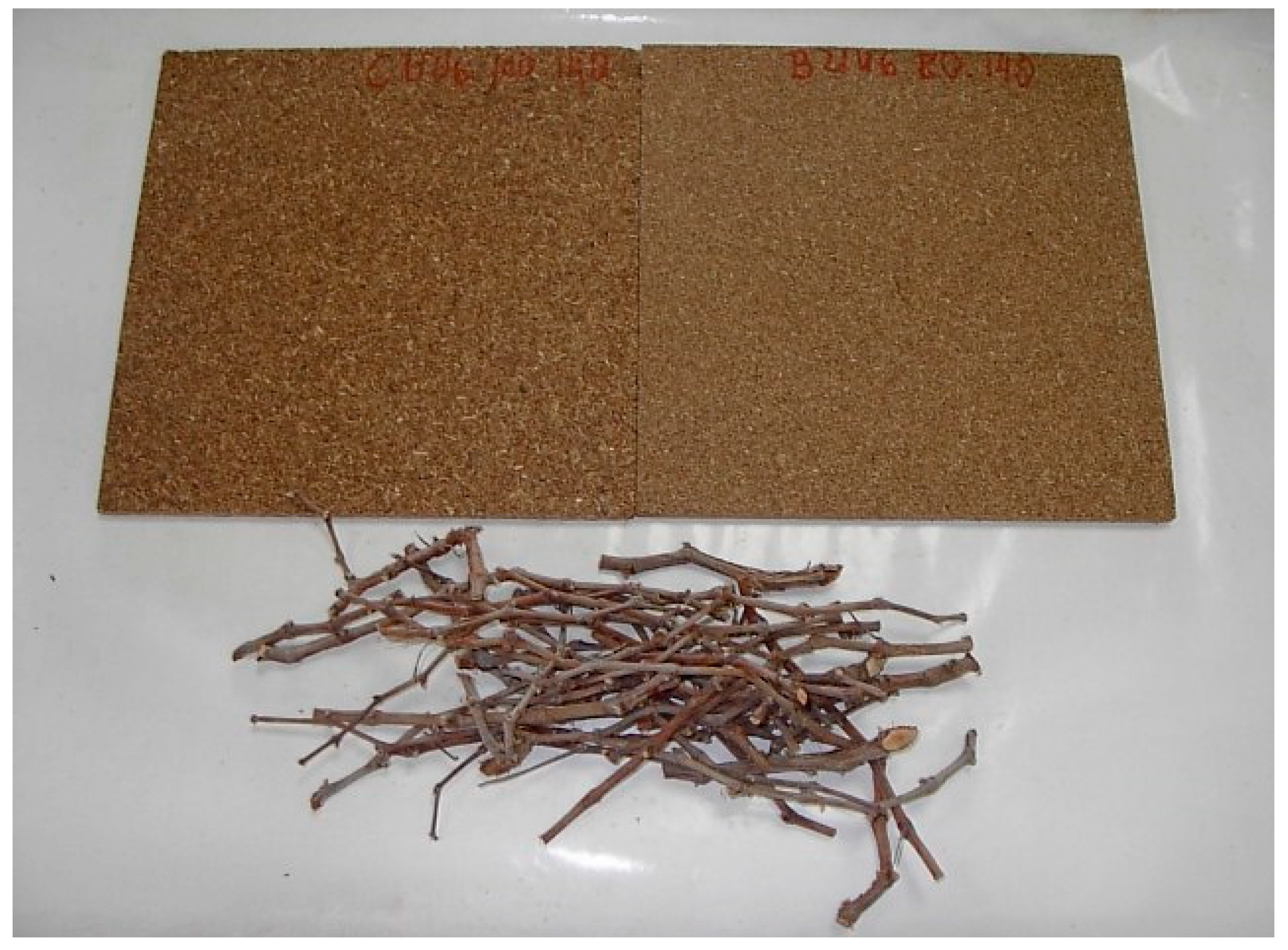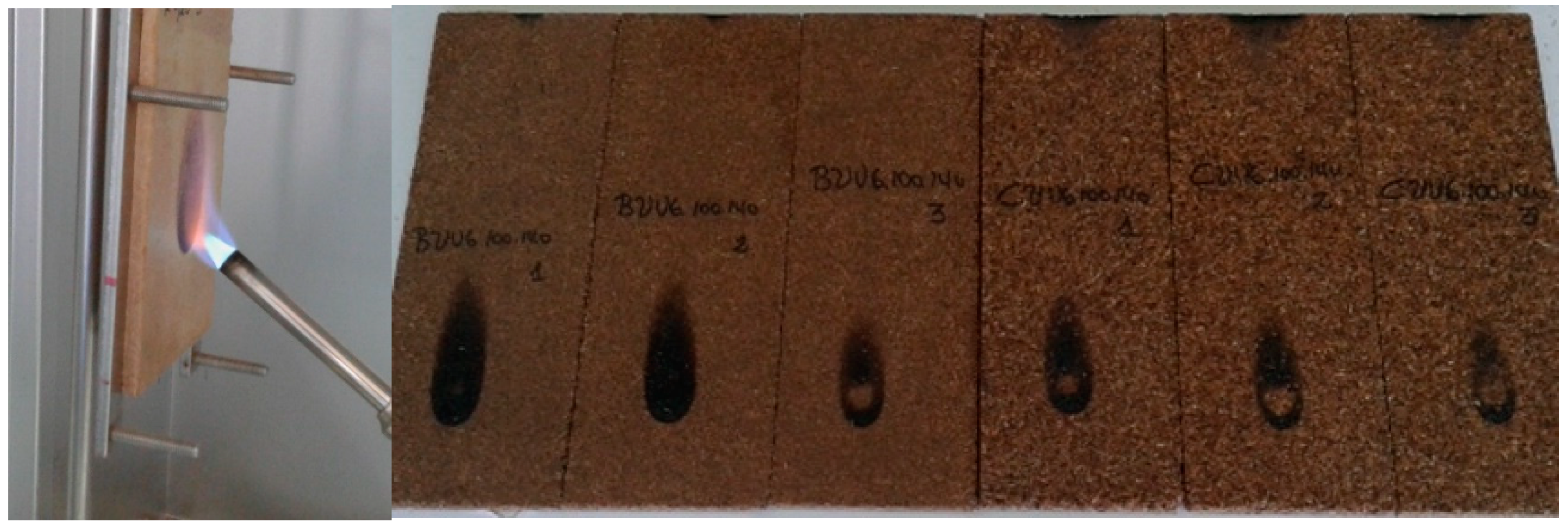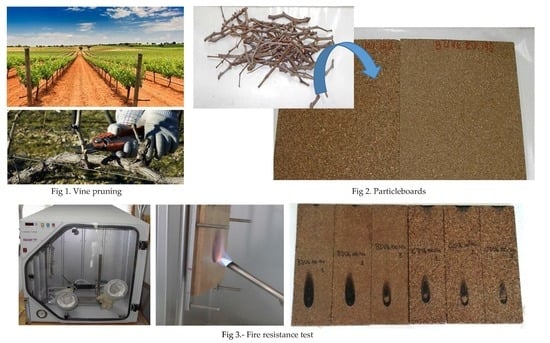Analysis of the Thermal Insulation and Fire-Resistance Capacity of Particleboards Made from Vine (Vitis vinifera L.) Prunings
Abstract
1. Introduction
2. Materials and Methods
3. Results and Discussion
3.1. Physical Properties
3.1.1. Density
3.1.2. Thickness Swelling and Water Absorption
3.1.3. Thermal Resistance and Conductivity
3.2. Mechanical Properties
3.3. Reaction-to-Fire Test Results
4. Conclusions
Author Contributions
Funding
Acknowledgments
Conflicts of Interest
References
- Aurand, J. OIV Statistical Report on World Vitiviniculture; International Organization of Vine and Wine: Paris, France, 2017. [Google Scholar]
- Lü, X.; Lu, T.; Lipponen, O.; Viljanen, M. Insulation Materials Made with Vegetable Fibres. In Nearly Zero Energy Building Refurbishment; Springer Science and Business Media LLC: Berlin, Germany, 2013; pp. 411–455. [Google Scholar]
- Ramírez, R.A.; Chinas-Castillo, F.; Morales-Dominguez, V.; Ortiz-Guzman, M. Thermal conductivity of coconut fibre filled ferrocement sandwich panels. Constr. Build. Mater. 2012, 37, 425–431. [Google Scholar] [CrossRef]
- Rojsitthisak, P.; Khunthon, S.; Siralertmukul, K.; Noomun, K.; Chandrkrachang, S. New insulating particleboards prepared from mixture of solid wastes from tissue paper manufacturing and corn peel. Bioresour. Technol. 2008, 99, 4841–4845. [Google Scholar] [CrossRef]
- Ardente, F.; Beccali, M.; Cellura, M.; Mistretta, M. Building energy performance: A LCA case study of kenaf-fibres insulation board. Energy Build. 2008, 40, 1–10. [Google Scholar] [CrossRef]
- Zhou, X.; Zheng, F.; Li, H.-G.; Lu, C.-L. An environment-friendly thermal insulation material from cotton stalk fibers. Energy Build. 2010, 42, 1070–1074. [Google Scholar] [CrossRef]
- Ferrández-Garcia, M.T.; Ferrández-García, C.E.; Andreu-Rodriguez, J.; Ferrández-Villena, M.; García-Ortuño, T. The suitability of utilising cotton stalk for low cost binderless panels. In Actual Tasks on Agricultural Engineering. In Proceedings of the 41 International Symposium on Agricultural Engineering, University of Zagreb, Faculty of Agriculture, Opatija, Croatia, 19–22 February 2013; pp. 388–392. [Google Scholar]
- Panyakaew, S.; Fotios, S. New thermal insulation boards made from coconut husk and bagasse. Energy Build. 2011, 43, 1732–1739. [Google Scholar] [CrossRef]
- Behzad, T.; Sain, M. Measurement and prediction of thermal conductivity for hemp fiber reinforced composites. Polym. Eng. Sci. 2007, 47, 977–983. [Google Scholar] [CrossRef]
- Benfratello, S.; Capitano, C.; Peri, G.; Rizzo, G.; Scaccianoce, G.; Sorrentino, G. Thermal and structural properties of a hemp–lime biocomposite. Constr. Build. Mater. 2013, 48, 745–754. [Google Scholar] [CrossRef]
- Chikhi, M.; Agoudjil, B.; Boudenne, A.; Gherabli, A. Experimental investigation of new biocomposite with low cost for thermal insulation. Energy Build. 2013, 66, 267–273. [Google Scholar] [CrossRef]
- Murphy, R.J.; Norton, A. Life Cycle Assessments of Natural Fibre Insulation Materials, National Non-Food Crops Centre; NNFCC: London, UK, 2008; p. 79. [Google Scholar]
- Kymäläinen, H.-R.; Sjöberg, A.-M. Flax and hemp fibres as raw materials for thermal insulations. Build. Env. 2008, 43, 1261–1269. [Google Scholar] [CrossRef]
- Ferrández-Garcia, C.C.; Garcia-Ortuño, T.; Ferrández-Garcia, M.T.; Ferrández-Villena, M.; Ferrández-García, C.E. Fire-resistance, Physical, and Mechanical Characterization of Binderless Rice Straw Particleboards. BioResources 2017, 12, 8539–8549. [Google Scholar]
- Kalaprasad, G.; Pradeep, P.; Mathew, G.; Pavithran, C.; Thomas, S. Thermal conductivity and thermal diffusivity analyses of low-density polyethylene composites reinforced with sisal, glass and intimately mixed sisal/glass fibres. Compos. Sci. Technol. 2000, 60, 2967–2977. [Google Scholar] [CrossRef]
- Liao, R.; Xu, J.; Umemura, K. Low Density Sugarcane Bagasse Particleboard Bonded with Citric Acid and Sucrose: Effect of board density and additive content. Bioresources 2016, 11, 2174–2185. [Google Scholar] [CrossRef]
- Ferrandez-Garcia, C.E.; Andreu-Rodriguez, J.; Ferrández-García, M.T.; Ferrandez-Villena, M.; Garcia-Ortuño, T. Panels made from giant reed bonded with non-modified starches. Bioresources 2012, 7, 5904–5916. [Google Scholar] [CrossRef]
- Ferrández García, C.C.; Ferrández-Villena, M.; Cuartero, J.; García-Ortuño, T.; Ferrández-García, M.T.; Andreu-Rodríguez, J. Manufacture and Properties of Three-Layered Low Density Particleboard from Giant Reed. In Structures and Environmental Technologies. In Proceedings of the International Conference of Agricultural Engineering-CIGR-AgEng 2012: Agriculture and Engineering for a Healthier Life, Valencia, Spain, 8–12 July 2012; 2012. [Google Scholar]
- Ferrández-García, A.; Ferrandez-Villena, M.; Garcia-Ortuño, T. Potential Use of Phoenix canariensis Biomass in Binderless Particleboards at Low Temperature and Pressure. Bioresources 2017, 12, 6698–6712. [Google Scholar] [CrossRef]
- Ferrández-García, C.C.; Ferrández-García, C.E.; Ferrández-Villena, M.; Ferrandez-García, M.T.; García-Ortuño, T. Acoustic and Thermal Evaluation of Palm Panels as Building Material. BioResources 2017, 12, 8047–8057. [Google Scholar]
- Ferrandez-Garcia, M.; Ferrandez-Garcia, C.; Garcia-Ortuño, T.; Ferrandez-Garcia, A.; Ferrandez-Villena, M. Experimental Evaluation of a New Giant Reed (Arundo Donax L.) Composite Using Citric Acid as a Natural Binder. Agronomy 2019, 9, 882. [Google Scholar] [CrossRef]
- Ntalos, G.A.; Grigoriou, A.H. Characterization and utilisation of vine prunings as a wood substitute for particleboard production. Ind. Crop. Prod. 2002, 16, 59–68. [Google Scholar] [CrossRef]
- Yasar, S.; Guntekin, E.; Cengiz, M.; Tanriverdi, H. The correlation of chemical characteristics and UF-Resin ratios to physical and mechanical properties of particleboard manufactured from vine prunings. Sci. Res. Essays 2010, 5, 737–741. [Google Scholar]
- Yeniocak, M.; Goktas, O.; Erdil, Y.Z.; Ozen, E.; Alma, M.H. Investigating the use of vine pruning stalks (Vitis vinifera L. CV. Sultani) as raw material for particleboard manufacturing. Wood Res. 2014, 59, 167–176. [Google Scholar]
- Ozen, E.; Goktas, O.; Kasal, A.; Efe, H.; Demirci, S. Bending moment capacity of L-type furniture corner joints constructed of particleboard produced from vine pruning residues. Wood Res. 2014, 59, 313–322. [Google Scholar]
- European Council. EU Construction Product Regulation No 305/2011; CPR. COST Action FP1404; European Council: Brussels, Belgium, 2014. [Google Scholar]
- Lazko, J.; Landercy, N.; Laoutid, F.; Dangreau, L.; Huguet, M.; Talon, O. Flame retardant treatments of insulating agro-materials from flax short fibres. Polym. Degrad. Stab. 2013, 98, 1043–1051. [Google Scholar] [CrossRef]
- Selamat, M.E.; Hui, T.Y.; Hashim, R.; Sulaiman, O.; Kassim, M.H.M.; Stalin, N.J. Division of Bioresource, Paper and Coatings Technology, School of Industrial Technology, Universiti Sains Malaysia, 11800 USM Pulau Pinang, Malaysia Properties of Particleboard Made from Oil Palm Trunks Added Magnesium Oxide as Fire Retardant. J. Phys. Sci. 2018, 29, 59–75. [Google Scholar] [CrossRef]
- Lee, C.H.; Sapuan, S.M.; Hassan, M.R. A Review of the Flammability Factors of Kenaf and Allied Fibre Reinforced Polymer Composites. Adv. Mater. Sci. Eng. 2014, 2014, 1–8. [Google Scholar] [CrossRef]
- EN 323. Wood-Based Panels. Determination of Density; European Committee for Standardization: Brussels, Belgium, 1993. [Google Scholar]
- EN 317. Particleboards and Fiberboards. Determination of Swelling in Thickness after Immersion in Water; European Committee for Standardization: Brussels, Belgium, 1993. [Google Scholar]
- EN 310. Wood-Based Panels. In Determination of Modulus of Elasticity in Bending and of Bending Strength; European Committee for Standardization: Brussels, Belgium, 1993. [Google Scholar]
- EN 319. Particleboards and Fiberboards. Determination of Tensile Strength Perpendicular to the Plane of de Board; European Committee for Standardization: Brussels, Belgium, 1993. [Google Scholar]
- EN 12667. Thermal Performance of Building Materials and Products: Determination of Thermal Resistance by Means of Guarded Hot Plate and Heat Flow Meter Methods: Products of High. and Medium Thermal Resistance; European Committee for Standardization: Brussels, Belgium, 2001. [Google Scholar]
- EN ISO 11925-2. Reaction to Fire Tests—Ignitability of Products Subjected to Direct Impingement of Flame—Part. 2: Single-Flame Source Test.; European Committee for Standardization: Brussels, Belgium, 2010. [Google Scholar]
- EN 13501-1 + A1. Fire Classification of Construction Products and Building Elements—Part. 1: Classification Using Data from Reaction to Fire Tests; European Committee for Standardization: Brussels, Belgium, 2009. [Google Scholar]
- EN 312. Particleboards. Specifications; European Committee for Standardization: Brussels, Belgium, 2010. [Google Scholar]
- Copur, Y.; Güler, C.; Akgul, M.; Taşçıoğlu, C.; Tascioglu, C. Some chemical properties of hazelnut husk and its suitability for particleboard production. Build. Env. 2007, 42, 2568–2572. [Google Scholar] [CrossRef]
- Kalaycioglu, H. Utilization of crops residues on particleboard production. Proc. Orenko 1992, 92, 288–292. [Google Scholar]
- Güler, C.; Ozen, R. Some properties of particleboards made from cotton stalks (Gossypium hirsitum L.). Holz Roh Werkst. 2004, 62, 40–43. [Google Scholar] [CrossRef]
- Bektas, I.; Guler, C.; Kalaycioglu, H. Manufacturing of particleboard from sunflower stalks (Helianthus annuus L.) using urea–formaldehyde resin. J. Sci. Eng. 2002, 5, 49–56. [Google Scholar]
- Alma, M.H.; Kalaycıoğlu, H.; Bektaş, I.; Tutus, A.; Kalaycioglu, H. Properties of cotton carpel-based particleboards. Ind. Crop. Prod. 2005, 22, 141–149. [Google Scholar] [CrossRef]
- Zheng, Y.; Pan, Z.; Zhang, R.; Jenkins, B.M.; Blunk, S. Particleboard quality characteristics of saline jose tall wheatgrass and chemical treatment effect. Bioresour. Technol. 2007, 98, 1304–1310. [Google Scholar] [CrossRef]
- Nicolajsen, A. Thermal transmittance of a cellulose loose-fill insulation material. Build. Env. 2005, 40, 907–914. [Google Scholar] [CrossRef]
- Agoudjil, B.; Benchabane, A.; Boudenne, A.; Ibos, L.; Fois, M. Renewable materials to reduce building heat loss: Characterization of date palm wood. Energy Build. 2011, 43, 491–497. [Google Scholar] [CrossRef]
- EN 13986 + A1. Wood-Based Panels for Use in Construction-Characteristics, Evaluation of Conformity and Marking; European Committee for Standardization: Brussels, Belgium, 2015. [Google Scholar]
- Hegazy, S.S.; Ahmed, K. Effect of Date Palm Cultivar, Particle Size, Panel Density and Hot Water Extraction on Particleboards Manufactured from Date Palm Fronds. Agriculture 2015, 5, 267–285. [Google Scholar] [CrossRef]
- ISO 3340. Fibre Building Boards. Determination of Sand Content; International Organization for Standardization: Genova, Italy, 1976. [Google Scholar]


| Type of Board | Particle Size (mm) | Pressing Pressure (MPa) | Pressing Time (min) |
|---|---|---|---|
| 1 | 0.25 to 1 | 2.0 | 4 |
| 2 | 0.25 to 1 | 2.0 | 6 |
| 3 | 0.25 to 1 | 2.6 | 4 |
| 4 | 0.25 to 1 | 2.6 | 6 |
| 5 | 1 to 2 | 2.0 | 4 |
| 6 | 1 to 2 | 2.0 | 6 |
| 7 | 1 to 2 | 2.6 | 4 |
| 8 | 1 to 2 | 2.6 | 6 |
| Type of Board | Thickness (mm) | Density (kg/m3) | TS 2 h (%) | TS 24 h (%) | WA 2 h (%) | WA 24 h (%) | Thermal Conductivity (W/(m·K)) | Thermal Resistance (m2·K/W) |
|---|---|---|---|---|---|---|---|---|
| 1 | 7.46 (0.55) | 865.36 (27.81) | 15.4 (1.8) | 26.9 (3.3) | 38.8 (10.8) | 60.8 (10.6) | 0.0673 (0.0005) | 0.1041 (0.008) |
| 2 | 7.25 (0.74) | 850.46 (18.59) | 15.7 (2.3) | 26.0 (2.1) | 48.9 (12.2) | 77.0 (9.1) | 0.0645 (0.0009) | 0.1086 (0.015) |
| 3 | 7.55 (0.90) | 911.69 (44.75) | 17.2 (1.0) | 29.6 (3.2) | 38.8 (11.0) | 71.5 (6.6) | 0.0646 (0.0011) | 0.1086 (0.015) |
| 4 | 7.49 (0.39) | 965.06 (41.36) | 16.4 (3.9) | 27.2 (2.7) | 37.3 (8.0) | 64.3 (7.2) | 0.0676 (0.0020) | 0.1036 (0.031) |
| 5 | 7.45 (0.22) | 782.94 (34.64) | 22.0 (3.3) | 30.4 (0.4) | 52.8 (26.59) | 79.1 (13.3) | 0.0642 (0.0005) | 0.1090 (0.009) |
| 6 | 7.48 (0.37) | 793.32 (37.11) | 21.3 (1.5) | 29.0 (3.4) | 52.5 (11.3) | 82.2 (7.3) | 0.0648 (0.0007) | 0.1079 (0.013) |
| 7 | 7.53 (0.70) | 820.87 (41.65) | 18.8 (8.7) | 31.6 (2.3) | 36.6 (6.1) | 77.1 (3.8) | 0.0654 (0.0001) | 0.1079 (0.013) |
| 8 | 7.53 (0.29) | 846.89 (30.58) | 21.8 (3.8) | 30.2 (1.9) | 44.1 (10.7) | 75.6 (6.0) | 0.0647 (0.0006) | 0.1083 (0.009) |
| Factor | Properties | Sum of Squares | d.f. | Half Quadratic | F | p-Value |
|---|---|---|---|---|---|---|
| Particle size | Density (kg/m3) | 69,936.105 | 1 | 69,936.105 | 27.262 | 0.000 |
| TS 24 h (%) | 74.295 | 1 | 74.295 | 10.442 | 0.003 | |
| WA 24 h (%) | 1,253.409 | 1 | 1,253.409 | 15.336 | 0.000 | |
| MOR (N/mm2) | 349.256 | 1 | 349.256 | 109.665 | 0.000 | |
| MOE (N/mm2) | 3,393,780.874 | 1 | 3,393,780.874 | 91.376 | 0.000 | |
| IB (N/mm2) | 0.765 | 1 | 0.765 | 13.975 | 0.001 | |
| Thermal C. (W/m·K) | 0.0000155 | 1 | 0.0000155 | 8.882 | 0.009 | |
| Thermal R. (m2·K/m) | 0.0000249 | 1 | 0.0000249 | 4.786 | 0.044 | |
| Pressing pressure | Density (kg/m3) | 40,607.929 | 1 | 40,607.929 | 11.932 | 0.001 |
| TS 24 h (%) | 18.187 | 1 | 18.187 | 2.086 | 0.158 | |
| WA 24 h (%) | 56.143 | 1 | 56.143 | 0.484 | 0.491 | |
| MOR (N/mm2) | 55.064 | 1 | 55.064 | 4.747 | 0.036 | |
| MOE (N/mm2) | 894,968.820 | 1 | 894,968.820 | 6.891 | 0.013 | |
| IB (N/mm2) | 0.280 | 1 | 0.280 | 4.382 | 0.049 | |
| Thermal C. (W/m·K) | 0.0000010 | 1 | 0.0000010 | 0.417 | 0.527 | |
| Thermal R. (m2·K/m) | 0.0000013 | 1 | 0.0000013 | 0.194 | 0.666 | |
| Pressing time | Density (kg/m3) | 2,258.231 | 1 | 2,258.231 | 0.502 | 0.483 |
| TS 24 h (%) | 5.773 | 1 | 5.773 | 0.636 | 0.430 | |
| WA 24 h (%) | 196.307 | 1 | 196.307 | 1.754 | 0.194 | |
| MOR (N/mm2) | 11.194 | 1 | 11.194 | 0.871 | 0.357 | |
| MOE (N/mm2) | 105,484.796 | 1 | 105,484.796 | 0.692 | 0.411 | |
| IB (N/mm2) | 0.280 | 1 | 0.280 | 4.091 | 0.048 | |
| Thermal C. (W/m·K) | 0.0000001 | 1 | 0.0000001 | 0.052 | 0.822 | |
| Thermal R. (m2·K/m) | 0.0000012 | 1 | 0.0000012 | 0.194 | 0.666 |
| Name | TS 24 h (%) | WA 24 h (%) | Source |
|---|---|---|---|
| Tobacco straw | 22.0 | - | [39] |
| Cotton stalks | 24.0 | 93.6 | [40] |
| Sunflower stalk | 25.0 | 95.0 | [41] |
| Cotton carpel | 26.0 | 153 | [42] |
| Wheatgrass | 41.7 | - | [43] |
| Vine prunings | 25.8 | 65.6 | [22] |
| 28.9 | 73.4 | Mean values in this work |
| Name | Thermal Conductivity λ (W/m K) | Source |
|---|---|---|
| Hemp | 0.111 | [9] |
| 0.040 to 0.094 | [13] | |
| Flax | 0.038 to 0.075 | [13] |
| 0.042 | [3] | |
| Cotton | 0.040 to 0.069 | [44] |
| Date palm rachis | 0.083 | [45] |
| Rice straw | 0.076 to 0.091 | [14] |
| Sisal | 0.070 | [15] |
| Sugarcane bagasse | 0.079 to 0.098 | [16] |
| Wood particleboards | 0.070 to 0.180 | [46] |
| Wood fiberboards | 0.050 to 0.140 | [46] |
| Vine prunings | 0.064 to 0.068 | This work |
| Type of Board | MOR (N/mm2) | MOE (N/mm2) | IB (N/mm2) |
|---|---|---|---|
| 1 | 13.6 (0.4) | 1,390 (87) | 1.32 (0.09) |
| 2 | 12.4 (1.0) | 1,300 (201) | 1.22 (0.05) |
| 3 | 15.3 (0.5) | 1,800 (36) | 1.70 (0.14) |
| 4 | 16.5 (0.8) | 1,810 (58) | 1.79 (0.13) |
| 5 | 8.72 (0.6) | 963 (106) | 1.92 (0.15) |
| 6 | 6.58 (1.0) | 743 (59) | 1.86 (0.08) |
| 7 | 8.88 (0.6) | 1,030 (73) | 1.45 (0.04) |
| 8 | 9.22 (0.6) | 1,080 (62) | 1.84 (0.14) |
| Type of Board | 1 | 2 | 3 | 4 | 5 | 6 | 7 | 8 |
|---|---|---|---|---|---|---|---|---|
| Weight loss (%) | 0.28 (0.04) | 0.17 (0.02) | 0.14 (0.01) | 0.18 (0.03) | 0.15 (0.04) | 0.22 (0.02) | 0.12 (0.01) | 0.15 (0.03) |
| Burn height (mm) (Fs) | 67.78 (1.17) | 48.96 (2.43) | 57.45 (1.75) | 45.60 (1.68) | 46.60 (0.94) | 47.28 (0.71) | 43.65 (1.75) | 41.04 (0.51) |
| Burn width (mm) | 23.12 (0.44) | 20.38 (0.67) | 22.25 (0.19) | 20.70 (0.82) | 19.81 (1.61) | 21.28 (0.69) | 20.37 (0.35) | 20.01 (0.15) |
| Board ignition | No | No | No | No | No | No | No | No |
| Filter paper ignition | No | No | No | No | No | No | No | No |
| Smoke | No | No | No | No | No | No | No | No |
© 2020 by the authors. Licensee MDPI, Basel, Switzerland. This article is an open access article distributed under the terms and conditions of the Creative Commons Attribution (CC BY) license (http://creativecommons.org/licenses/by/4.0/).
Share and Cite
Ferrandez-Villena, M.; Ferrandez-Garcia, C.E.; Garcia-Ortuño, T.; Ferrandez-Garcia, A.; Ferrandez-Garcia, M.T. Analysis of the Thermal Insulation and Fire-Resistance Capacity of Particleboards Made from Vine (Vitis vinifera L.) Prunings. Polymers 2020, 12, 1147. https://doi.org/10.3390/polym12051147
Ferrandez-Villena M, Ferrandez-Garcia CE, Garcia-Ortuño T, Ferrandez-Garcia A, Ferrandez-Garcia MT. Analysis of the Thermal Insulation and Fire-Resistance Capacity of Particleboards Made from Vine (Vitis vinifera L.) Prunings. Polymers. 2020; 12(5):1147. https://doi.org/10.3390/polym12051147
Chicago/Turabian StyleFerrandez-Villena, Manuel, Clara Eugenia Ferrandez-Garcia, Teresa Garcia-Ortuño, Antonio Ferrandez-Garcia, and Maria Teresa Ferrandez-Garcia. 2020. "Analysis of the Thermal Insulation and Fire-Resistance Capacity of Particleboards Made from Vine (Vitis vinifera L.) Prunings" Polymers 12, no. 5: 1147. https://doi.org/10.3390/polym12051147
APA StyleFerrandez-Villena, M., Ferrandez-Garcia, C. E., Garcia-Ortuño, T., Ferrandez-Garcia, A., & Ferrandez-Garcia, M. T. (2020). Analysis of the Thermal Insulation and Fire-Resistance Capacity of Particleboards Made from Vine (Vitis vinifera L.) Prunings. Polymers, 12(5), 1147. https://doi.org/10.3390/polym12051147







